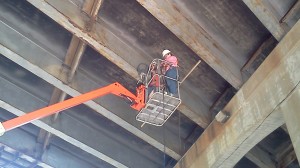
UM civil engineering graduate students take vibration measurements on University Avenue bridge over Gertrude Ford Boulevard.
OXFORD, Miss. – As Mississippi lawmakers continue to examine means to fund a $375 million proposal for state highways and bridges, University of Mississippi civil engineers are developing new ways to assist with inspections and maintenance.
The Mississippi Economic Council and state Chamber of Commerce released a report in December advising that Mississippi needs to invest funds to replace 562 deficient bridges and repave many roads. Though financial sources remain uncertain, the report suggests lawmakers consider higher fuel taxes, license plate fees, rental car taxes and/or general sales taxes.
“For several years now, the University of Mississippi has been a leading contributor in helping MDOT with these infrastructure challenges,” said Waheed Uddin, professor of civil engineering and director of the Center for Advanced Infrastructure Technology at UM. “Through our collaborative efforts with them and researchers at other universities, we have developed programs that have repeatedly proven successful in achieving transportation objectives.”
The university’s researchers have developed ways to use such high-tech tools as computational modeling, laser-assisted measuring devices and more to help MDOT monitor bridges and roads throughout the state.
For example, Uddin’s CAIT lab has conducted two MDOT Research Division studies since Hurricane Katrina in 2005, using ground-penetrating radar to assess the structural integrity of state highways and to check bridges.

UM civil engineering professor Elizabeth Ervin (right) inspects the University Avenue bridge for weaknesses.
Working with the university’s National Center for Computational Hydroscience and Engineering, Uddin and his students also have used extreme flood simulation results and created three-dimensional computational models of bridges to show how catastrophic failures happen. This work is helping improve the resilience of bridges built over streams and rivers.
“When funding is extremely limited, asset management becomes all the more important,” said Uddin, who serves as a member of the Mississippi Transportation Institute board of directors. “By using a Highway Asset Management System, MDOT has been able to monitor existing roads and bridges for maintenance, safety and stability.”
Another project, a partnership with MDOT’s Construction Division and NASA, has yielded a laser technology to conduct aerial surveys for highway and bridge design alignment.
“Most states’ Department of Transportation agencies now use this technology, which was evaluated for accuracy and cost right here at the University of Mississippi,” Uddin said.
The MDOT Traffic Engineering Division worked with Ole Miss professors when deciding to conduct a field performance study of roundabouts on South Lamar Avenue in Oxford.
Following the construction of roundabouts on both ends of the Highway 6 bridge on South Lamar – which have proven highly successful in promoting safety and traffic flow – the roundabout project was selected as one of the Sweet 16 projects for national recognition by American Association of State Highways and Transportation officials.
Roundabouts were later built on Old Taylor Road, easing traffic flow on the Highway 6 bridge on this major link between the Ole Miss campus and new housing developments in Oxford and Lafayette County.
Another important new tool is a software package called Structural Health Evaluation, developed by Elizabeth Ervin, associate professor of civil engineering.
The system measures vibrations on a bridge to locate its weakest points. The measurements can usually be taken in less than a day and do not require roads to be closed. Data collected has the potential to help inspectors better determine which bridges are most likely to fail and how to best address the issues.
“Visual observation alone of bridges is no longer the best way to select and prioritize them for repairs,” Ervin said. “While the vibration sensors can’t make predictions, it can help inspectors know which bridges are weakest and most likely to fail first.”
Chris Mullen, another Ole Miss civil engineering professor, is using computational modeling to help determine which structural parts are most likely to cause critical failure (such as in the case of the I-35 bridge in Minneapolis in 2015). Combining Mullen’s modeling technology and Ervin’s vibration sensors could greatly enhance the effectiveness of bridge inspection practices, Ervin said.

UM civil engineering professor Waheed Uddin checks data using terrain laser mapping sensor equipment aboard an aircraft.
“Of course, no one can accurately predict exactly when a structure will fail,” she said. “We can only give our best guesses about when it might occur and, based on that data, determine a plan of action. Lowering truck weight limits alone is not a guarantee. Research and technology offer better alternatives.”
Uddin and Ervin both said they’re hopeful that funding for infrastructure improvements can be found.
“We’re certainly very hopeful that the Mississippi Legislature will pass the MDOT funding proposal,” Uddin said. “We want to continue offering our expertise in partnership with other institutions and agencies for the good of all transportation users.”
“This proposal, if it passes, is a good start,” Ervin said. “Still, the maintenance of existing bridges and highways, not to mention the possible construction of new ones, is a mind-boggling problem. We still have a long, long way to go.”